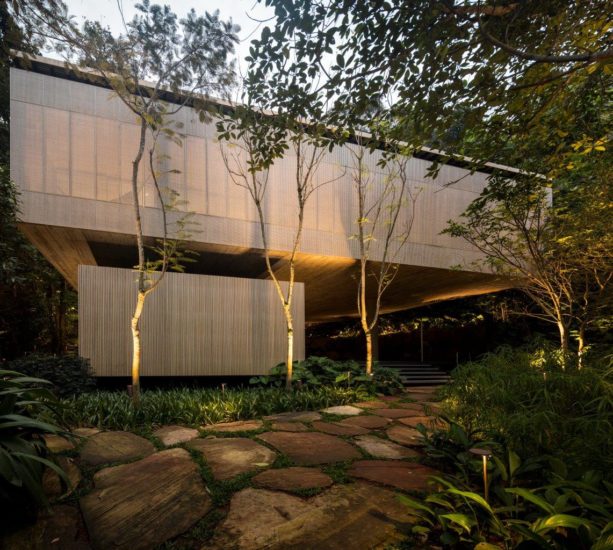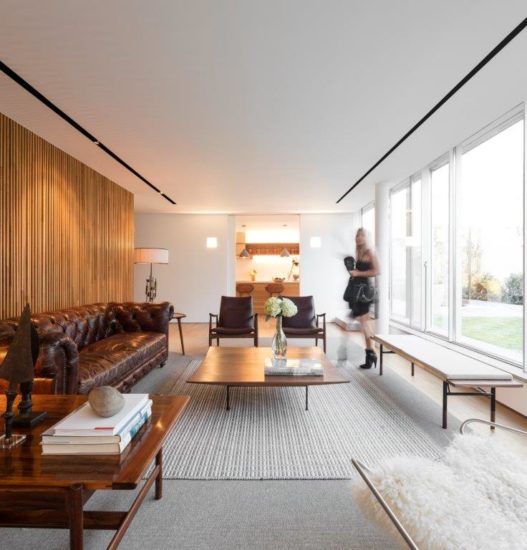How architects are devising building architecture to reap the benefits that the sunny, humid environment throws at them. We look at the works of Oppenheim Architecture + Design, and Studio MK27.
Credits: Caledonian Somosaguas – Photography: Fernando Guerra; Jungle House – Photography: Fernando Guerra

House on a Dune on Harbour Island, the Bahamas by Oppenheim Architecture + Design
Having evolved beyond its modernist roots, contemporary tropical architecture offers timeless design solutions that work effectively within their context. When first emerged as a style in the early 1930s, Modernism quickly came to define a functional approach of creating pure and clean forms of design that followed a certain aesthetic. As the style spread all over the world, however, its adaptability gave rise to a new way of making architecture, receptive to specific cultural traditions and climatic conditions and combining contemporary forms with locally responsive design considerations, appropriate to their context.

House on a Dune affords spacious living rooms with pared-down design
Today, Tropical Modernism is a version evolved from its mid-century beginnings. Softened and adapted to the tropical conditions, with local materials and techniques better suited to their environment, Tropical Modernism is now sometimes a style, sometimes a term applied liberally across architecture that carries the elements of modernism. It takes cues from its locality and integrates sustainable and passive design elements, often borrowed from local, indigenous architectural forms. Read about this desert lodge in Namibia.
Enduring Designs
Aesthetically, it is, in many ways, the inherent timelessness and utility of contemporary tropical design that has made it universally appealing to architects working in hot climates. The style combines simple, clean lines and muted colours with local, low-maintenance materials, woods and stone that have become signature of many vacation and island homes around the world. The look is popular not only in glamorous resorts in Bali, Hawaii, the Maldives but also in private homes that are borrowing design elements from local vernacular traditions and contemporising them for a timeless effect.
Transcending the specific locations, contemporary tropical design can be seen in countries and regions around the world, from Brazil to the United States, to Sri Lanka and Southeast Asia, with unique adaptations based on the specificities of each location contributing to its adaptability around the globe.

Steps leading to Jungle House in Brazil by Studio MK27
In Brazil, for example, Studio MK27 is paving the way in adapting Brazilian Modernist architecture produced between the 1930s and 1970s by architects like Lucio Costa, Oscar Niemeyer and, more recently, Paulo Mendes de Rocha, and creating a dialogue between the early philosophies of the movement and locality-based solutions, adding a dose of Brazilian sensuality to it. “Our architecture is somehow the fruit of this generation of architects, this architecture and this intense modern dialogue, always rethought for current situations,” says Studio MK27’s founder Marcio Kogan. “It is our mission to give continuity to this movement, in a contemporary way. I don’t think this movement will ever die.”

Jungle House – Spacious living room looks out to verdant landscapes
Studio MK27’s projects are, indeed, rooted in their context. The firm’s Jungle House in Brazil is a true extension of the region’s mountainous topography with dense vegetation. The contact points between the building and the slope in which the house sits were shaped to respect the existing land – the structure touches the ground with only two pillars. Another project by Studio MK27 in Madrid, Spain – Caledonian Somosaguas development – incorporates influences of Spanish pueblos into its arrangement to create a residential habitat, where houses are loosely arranged around a web of public spaces, streets, plazas, parks and a pool. The residences are interwoven with each other, while still maintaining the sense of privacy, with sheltered courtyard gardens, walled roof terraces and solid upper storeys.
Raw and Timeless
In the United States, Oppenheim Architecture + Design similarly operates under the philosophy of letting the uniqueness of specific places shine through the firm’s work simple yet profound ways by connecting to the context. “Architecture should try to give you the possibility of creating the most pleasurable environment in a specific place,” says founder Chad Oppenheim. “So much of what I do is about reconnecting people with nature, helping them focus on analogue instead of digital experiences.”

An aerial view of the precinct of Caledonian Somosaguas development by Studio MK27
For the House on a Dune on Harbour Island in the Bahamas, Oppenheim Architecture took precisely the contextual approach, taking inspiration from the raw yet timeless location to drive the architecture of the private residence to establish a meditative place that sits between a lush tropical landscape and wide oceanfront. The house’s main central space is actually an open breezeway allowing visual connectivity to nature and connections to the main living spaces. The living and dining areas open onto verandas protected from the elements by deep overhangs of the gabled roof, further connecting the house to nature.

A home inside Caledonian Somosaguas development by Studio MK27
Allowing for unique design adaptations to diverse contexts, contemporary tropical architecture has grown up, matured and graduated into a movement in its own right. Deeply rooted in and appreciative of locality, it offers an appropriate response that makes sense in the context of the tropics, utilising the environmental conditions, climate and local influences to create authentic design responses that work best for their location.
